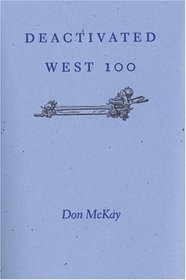Search -
Deactivated West 100
Deactivated West 100
Author:
Deactivated West 100 is Don McKay?s latest set of variations on a poetics of place. Armed with lunch and relevant reading material, McKay invites us to join him on Vancouver Island for a series of explorations that depend on first losing our way. In the spirit of Vis à Vis (Gaspereau Press, 2001), McKay embarks on a project to loca... more »
Author:
Deactivated West 100 is Don McKay?s latest set of variations on a poetics of place. Armed with lunch and relevant reading material, McKay invites us to join him on Vancouver Island for a series of explorations that depend on first losing our way. In the spirit of Vis à Vis (Gaspereau Press, 2001), McKay embarks on a project to loca... more »
ISBN-13: 9781554470082
ISBN-10: 1554470080
Publication Date: 9/30/2005
Pages: 112
Edition: First Edition
Rating: ?
ISBN-10: 1554470080
Publication Date: 9/30/2005
Pages: 112
Edition: First Edition
Rating: ?
0 stars, based on 0 rating
Publisher: Gaspereau Press
Book Type: Paperback
Other Versions: Hardcover
Members Wishing: 0
Reviews: Amazon | Write a Review
Book Type: Paperback
Other Versions: Hardcover
Members Wishing: 0
Reviews: Amazon | Write a Review
Genres:
- Literature & Fiction >> Books & Reading >> General
- Literature & Fiction >> History & Criticism >> Criticism & Theory >> General
- Literature & Fiction >> Poetry >> Single Authors >> United States
- Literature & Fiction >> World Literature >> United States >> Classics >> General
- Literature & Fiction >> Poetry >> Regional & Cultural >> United States >> 20th Century
- Literature & Fiction >> Poetry >> Regional & Cultural >> United States >> General
- Literature & Fiction >> Poetry >> Poets, A-Z >> ( M ) >> McKay, Don
- Outdoors & Nature >> Environment >> Ecology




